Kaikui Liu
Comprehensive Comparison Network: a framework for locality-aware, routes-comparable and interpretable route recommendation
Aug 12, 2025Abstract:Route recommendation (RR) is a core task of route planning in the Amap app, with the goal of recommending the optimal route among candidate routes to users. Unlike traditional recommendation methods, insights into the local quality of routes and comparisons between candidate routes are crucial for enhancing recommendation performance but often overlooked in previous studies. To achieve these, we propose a novel model called Comprehensive Comparison Network (CCN). CCN not only uses query-level features (e.g. user features) and item-level features (e.g. route features, item embedding) that are common in traditional recommendations, but also introduces comparison-level features which describe the non-overlapping segments between different routes to capture the local quality of routes. The key component Comprehensive Comparison Block (CCB) in CCN is designed to enable comparisons between routes. CCB includes a Comprehensive Comparison Operator (CCO) and a multi-scenario MLP, which can update the representations of candidate routes based on a comprehensive comparison. By stacking multiple CCBs, CCN can determine the final scores of candidate routes and recommend the optimal one to the user. Additionally, since routes directly affect the costs and risks experienced by users, the RR model must be interpretable for online deployment. Therefore, we designed an interpretable pair scoring network to achieve interpretability. Both offline and online experiments demonstrate that CCN significantly improves RR performance and exhibits strong interpretability. CCN has been fully deployed in the Amap app for over a year, providing stable and optimal benefits for route recommendations.
Effective Probabilistic Time Series Forecasting with Fourier Adaptive Noise-Separated Diffusion
May 16, 2025Abstract:We propose the Fourier Adaptive Lite Diffusion Architecture (FALDA), a novel probabilistic framework for time series forecasting. First, we introduce the Diffusion Model for Residual Regression (DMRR) framework, which unifies diffusion-based probabilistic regression methods. Within this framework, FALDA leverages Fourier-based decomposition to incorporate a component-specific architecture, enabling tailored modeling of individual temporal components. A conditional diffusion model is utilized to estimate the future noise term, while our proposed lightweight denoiser, DEMA (Decomposition MLP with AdaLN), conditions on the historical noise term to enhance denoising performance. Through mathematical analysis and empirical validation, we demonstrate that FALDA effectively reduces epistemic uncertainty, allowing probabilistic learning to primarily focus on aleatoric uncertainty. Experiments on six real-world benchmarks demonstrate that FALDA consistently outperforms existing probabilistic forecasting approaches across most datasets for long-term time series forecasting while achieving enhanced computational efficiency without compromising accuracy. Notably, FALDA also achieves superior overall performance compared to state-of-the-art (SOTA) point forecasting approaches, with improvements of up to 9%.
DSFNet: Learning Disentangled Scenario Factorization for Multi-Scenario Route Ranking
Mar 30, 2024



Abstract:Multi-scenario route ranking (MSRR) is crucial in many industrial mapping systems. However, the industrial community mainly adopts interactive interfaces to encourage users to select pre-defined scenarios, which may hinder the downstream ranking performance. In addition, in the academic community, the multi-scenario ranking works only come from other fields, and there are no works specifically focusing on route data due to lacking a publicly available MSRR dataset. Moreover, all the existing multi-scenario works still fail to address the three specific challenges of MSRR simultaneously, i.e. explosion of scenario number, high entanglement, and high-capacity demand. Different from the prior, to address MSRR, our key idea is to factorize the complicated scenario in route ranking into several disentangled factor scenario patterns. Accordingly, we propose a novel method, Disentangled Scenario Factorization Network (DSFNet), which flexibly composes scenario-dependent parameters based on a high-capacity multi-factor-scenario-branch structure. Then, a novel regularization is proposed to induce the disentanglement of factor scenarios. Furthermore, two extra novel techniques, i.e. scenario-aware batch normalization and scenario-aware feature filtering, are developed to improve the network awareness of scenario representation. Additionally, to facilitate MSRR research in the academic community, we propose MSDR, the first large-scale publicly available annotated industrial Multi-Scenario Driving Route dataset. Comprehensive experimental results demonstrate the superiority of our DSFNet, which has been successfully deployed in AMap to serve the major online traffic.
A General Framework for Debiasing in CTR Prediction
Dec 06, 2021



Abstract:Most of the existing methods for debaising in click-through rate (CTR) prediction depend on an oversimplified assumption, i.e., the click probability is the product of observation probability and relevance probability. However, since there is a complicated interplay between these two probabilities, these methods cannot be applied to other scenarios, e.g. query auto completion (QAC) and route recommendation. We propose a general debiasing framework without simplifying the relationships between variables, which can handle all scenarios in CTR prediction. Simulation experiments show that: under the simplest scenario, our method maintains a similar AUC with the state-of-the-art methods; in other scenarios, our method achieves considerable improvements compared with existing methods. Meanwhile, in online experiments, the framework also gains significant improvements consistently.
R4: A Framework for Route Representation and Route Recommendation
Oct 25, 2021



Abstract:Route recommendation is significant in navigation service. Two major challenges for route recommendation are route representation and user representation. Different from items that can be identified by unique IDs in traditional recommendation, routes are combinations of links (i.e., a road segment and its following action like turning left) and the number of combinations could be close to infinite. Besides, the representation of a route changes under different scenarios. These facts result in severe sparsity of routes, which increases the difficulty of route representation. Moreover, link attribute deficiencies and errors affect preciseness of route representation. Because of the sparsity of routes, the interaction data between users and routes are also sparse. This makes it not easy to acquire user representation from historical user-item interactions as traditional recommendations do. To address these issues, we propose a novel learning framework R4. In R4, we design a sparse & dense network to obtain representations of routes. The sparse unit learns link ID embeddings and aggregates them to represent a route, which captures implicit route characteristics and subsequently alleviates problems caused by link attribute deficiencies and errors. The dense unit extracts implicit local features of routes from link attributes. For user representation, we utilize a series of historical navigation to extract user preference. R4 achieves remarkable performance in both offline and online experiments.
Denoising User-aware Memory Network for Recommendation
Jul 12, 2021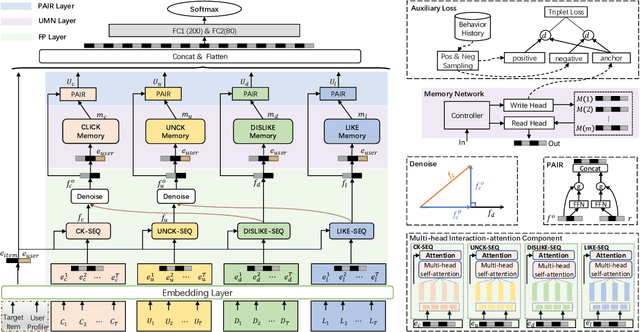
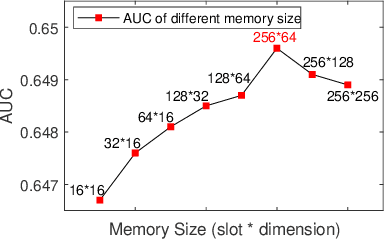

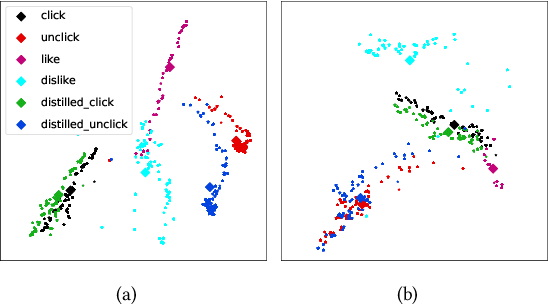
Abstract:For better user satisfaction and business effectiveness, more and more attention has been paid to the sequence-based recommendation system, which is used to infer the evolution of users' dynamic preferences, and recent studies have noticed that the evolution of users' preferences can be better understood from the implicit and explicit feedback sequences. However, most of the existing recommendation techniques do not consider the noise contained in implicit feedback, which will lead to the biased representation of user interest and a suboptimal recommendation performance. Meanwhile, the existing methods utilize item sequence for capturing the evolution of user interest. The performance of these methods is limited by the length of the sequence, and can not effectively model the long-term interest in a long period of time. Based on this observation, we propose a novel CTR model named denoising user-aware memory network (DUMN). Specifically, the framework: (i) proposes a feature purification module based on orthogonal mapping, which use the representation of explicit feedback to purify the representation of implicit feedback, and effectively denoise the implicit feedback; (ii) designs a user memory network to model the long-term interests in a fine-grained way by improving the memory network, which is ignored by the existing methods; and (iii) develops a preference-aware interactive representation component to fuse the long-term and short-term interests of users based on gating to understand the evolution of unbiased preferences of users. Extensive experiments on two real e-commerce user behavior datasets show that DUMN has a significant improvement over the state-of-the-art baselines. The code of DUMN model has been uploaded as an additional material.
LRC-BERT: Latent-representation Contrastive Knowledge Distillation for Natural Language Understanding
Dec 14, 2020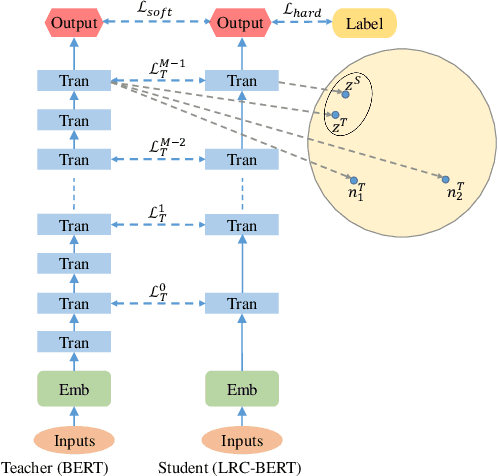

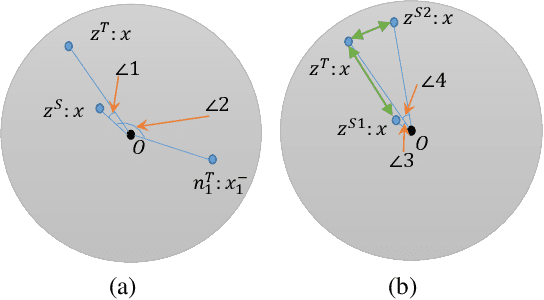

Abstract:The pre-training models such as BERT have achieved great results in various natural language processing problems. However, a large number of parameters need significant amounts of memory and the consumption of inference time, which makes it difficult to deploy them on edge devices. In this work, we propose a knowledge distillation method LRC-BERT based on contrastive learning to fit the output of the intermediate layer from the angular distance aspect, which is not considered by the existing distillation methods. Furthermore, we introduce a gradient perturbation-based training architecture in the training phase to increase the robustness of LRC-BERT, which is the first attempt in knowledge distillation. Additionally, in order to better capture the distribution characteristics of the intermediate layer, we design a two-stage training method for the total distillation loss. Finally, by verifying 8 datasets on the General Language Understanding Evaluation (GLUE) benchmark, the performance of the proposed LRC-BERT exceeds the existing state-of-the-art methods, which proves the effectiveness of our method.
Hybrid Spatio-Temporal Graph Convolutional Network: Improving Traffic Prediction with Navigation Data
Jun 23, 2020



Abstract:Traffic forecasting has recently attracted increasing interest due to the popularity of online navigation services, ridesharing and smart city projects. Owing to the non-stationary nature of road traffic, forecasting accuracy is fundamentally limited by the lack of contextual information. To address this issue, we propose the Hybrid Spatio-Temporal Graph Convolutional Network (H-STGCN), which is able to "deduce" future travel time by exploiting the data of upcoming traffic volume. Specifically, we propose an algorithm to acquire the upcoming traffic volume from an online navigation engine. Taking advantage of the piecewise-linear flow-density relationship, a novel transformer structure converts the upcoming volume into its equivalent in travel time. We combine this signal with the commonly-utilized travel-time signal, and then apply graph convolution to capture the spatial dependency. Particularly, we construct a compound adjacency matrix which reflects the innate traffic proximity. We conduct extensive experiments on real-world datasets. The results show that H-STGCN remarkably outperforms state-of-the-art methods in various metrics, especially for the prediction of non-recurring congestion.
 Add to Chrome
Add to Chrome Add to Firefox
Add to Firefox Add to Edge
Add to Edge